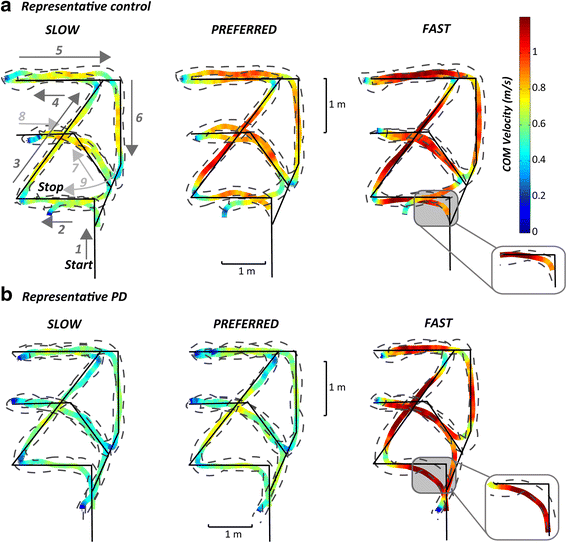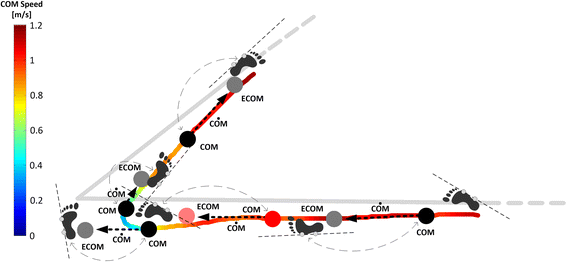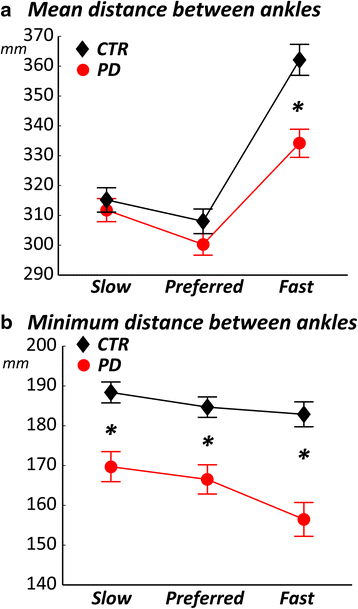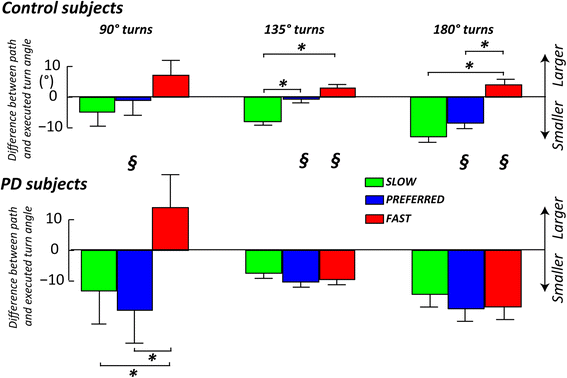The quality of turning in Parkinson's disease: a compensatory strategy to prevent postural instability?
- PMID: 27094039
- PMCID: PMC4837520
- DOI: 10.1186/s12984-016-0147-4
The quality of turning in Parkinson's disease: a compensatory strategy to prevent postural instability?
Abstract
Background: The ability to turn while walking is essential for daily living activities. Turning is slower and more steps are required to complete a turn in people with Parkinson's disease (PD) compared to control subjects but it is unclear whether this altered strategy is pathological or compensatory. The aim of our study is to characterize the dynamics of postural stability during continuous series of turns while walking at various speeds in subjects with PD compared to control subjects. We hypothesize that people with PD slow their turns to compensate for impaired postural stability.
Method: Motion analysis was used to compare gait kinematics between 12 subjects with PD in their ON state and 19 control subjects while walking continuously on a route composed of short, straight paths interspersed with eleven right and left turns between 30 and 180°. We asked subjects to perform the route at three different speeds: preferred, faster, and slower. Features describing gait spatio-temporal parameters and turning characteristics were extracted from marker trajectories. In addition, to quantify dynamic stability during turns we calculated the distance between the lateral edge of the base of support and the body center of mass, as well as the extrapolated body center of mass.
Results: Subjects with PD had slower turns and did not widen the distance between their feet for turning, compared to control subjects. Subjects with PD tended to cut short their turns compared to control subjects, resulting in a shorter walking path. Dynamic stability was smaller in the PD, compared to the healthy group, particularly for fast turning angles of 90°.
Conclusions: The slower turning speeds and larger turning angles in people with PD might reflect a compensatory strategy to prevent dynamic postural instability given their narrow base of support.
Keywords: Dynamic stability; Parkinson’s disease; Turning.
Figures





Similar articles
-
Continuous monitoring of turning in Parkinson's disease: Rehabilitation potential.NeuroRehabilitation. 2015;37(1):3-10. doi: 10.3233/NRE-151236. NeuroRehabilitation. 2015. PMID: 26409689 Free PMC article.
-
Narrow-based gait in people with Parkinson's disease: Its mechanisms explored.J Parkinsons Dis. 2025 Mar;15(2):329-337. doi: 10.1177/1877718X241313333. Epub 2025 Feb 2. J Parkinsons Dis. 2025. PMID: 39973508
-
Turning Stability in Individuals With Parkinson Disease.J Neurol Phys Ther. 2018 Oct;42(4):241-247. doi: 10.1097/NPT.0000000000000242. J Neurol Phys Ther. 2018. PMID: 30138233 Clinical Trial.
-
Turning problems and freezing of gait in Parkinson's disease: a systematic review and meta-analysis.Disabil Rehabil. 2019 Dec;41(25):2994-3004. doi: 10.1080/09638288.2018.1483429. Epub 2018 Jun 30. Disabil Rehabil. 2019. PMID: 29961369
-
Gait characteristics and falls in Parkinson's disease: A systematic review and meta-analysis.Parkinsonism Relat Disord. 2018 Dec;57:1-8. doi: 10.1016/j.parkreldis.2018.07.008. Epub 2018 Jul 17. Parkinsonism Relat Disord. 2018. PMID: 30041848
Cited by
-
Visual Cues for Turning in Parkinson's Disease.Sensors (Basel). 2022 Sep 7;22(18):6746. doi: 10.3390/s22186746. Sensors (Basel). 2022. PMID: 36146096 Free PMC article.
-
Assessment of the ability of open- and closed-loop cueing to improve turning and freezing in people with Parkinson's disease.Sci Rep. 2018 Aug 24;8(1):12773. doi: 10.1038/s41598-018-31156-4. Sci Rep. 2018. PMID: 30143726 Free PMC article.
-
Unraveling the threads of stability: A review of the neurophysiology of postural control in Parkinson's disease.Neurotherapeutics. 2024 Apr;21(3):e00354. doi: 10.1016/j.neurot.2024.e00354. Epub 2024 Apr 4. Neurotherapeutics. 2024. PMID: 38579454 Free PMC article. Review.
-
Pharmacological treatment in Parkinson's disease: Effects on gait.Parkinsonism Relat Disord. 2016 Oct;31:3-13. doi: 10.1016/j.parkreldis.2016.07.006. Epub 2016 Jul 17. Parkinsonism Relat Disord. 2016. PMID: 27461783 Free PMC article. Review.
-
TURN-IT: a novel turning intervention program to improve quality of turning in daily life in people with Parkinson's disease.BMC Neurol. 2022 Nov 28;22(1):442. doi: 10.1186/s12883-022-02934-5. BMC Neurol. 2022. PMID: 36443737 Free PMC article. Clinical Trial.
References
Publication types
MeSH terms
Grants and funding
LinkOut - more resources
Full Text Sources
Other Literature Sources
Medical
Miscellaneous

